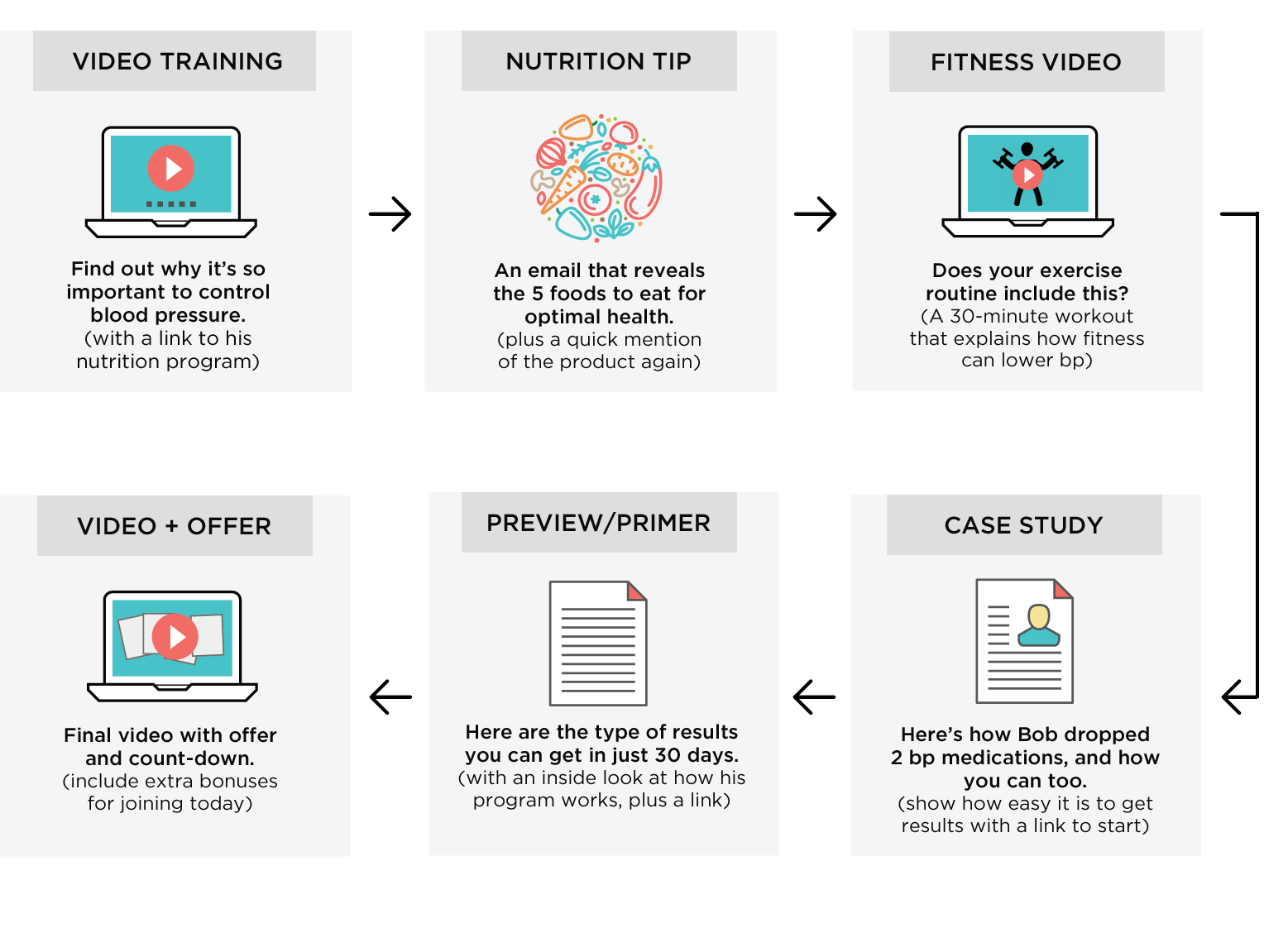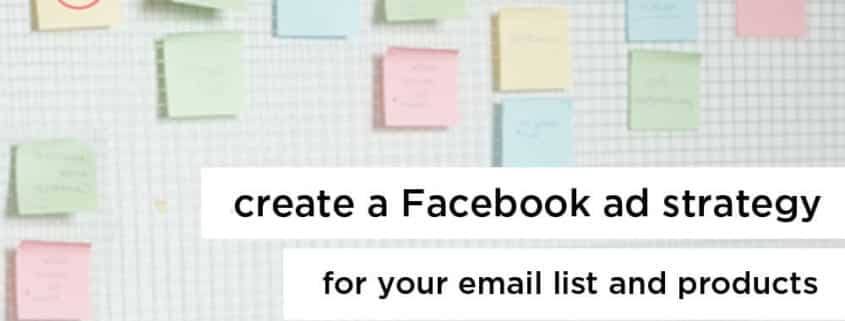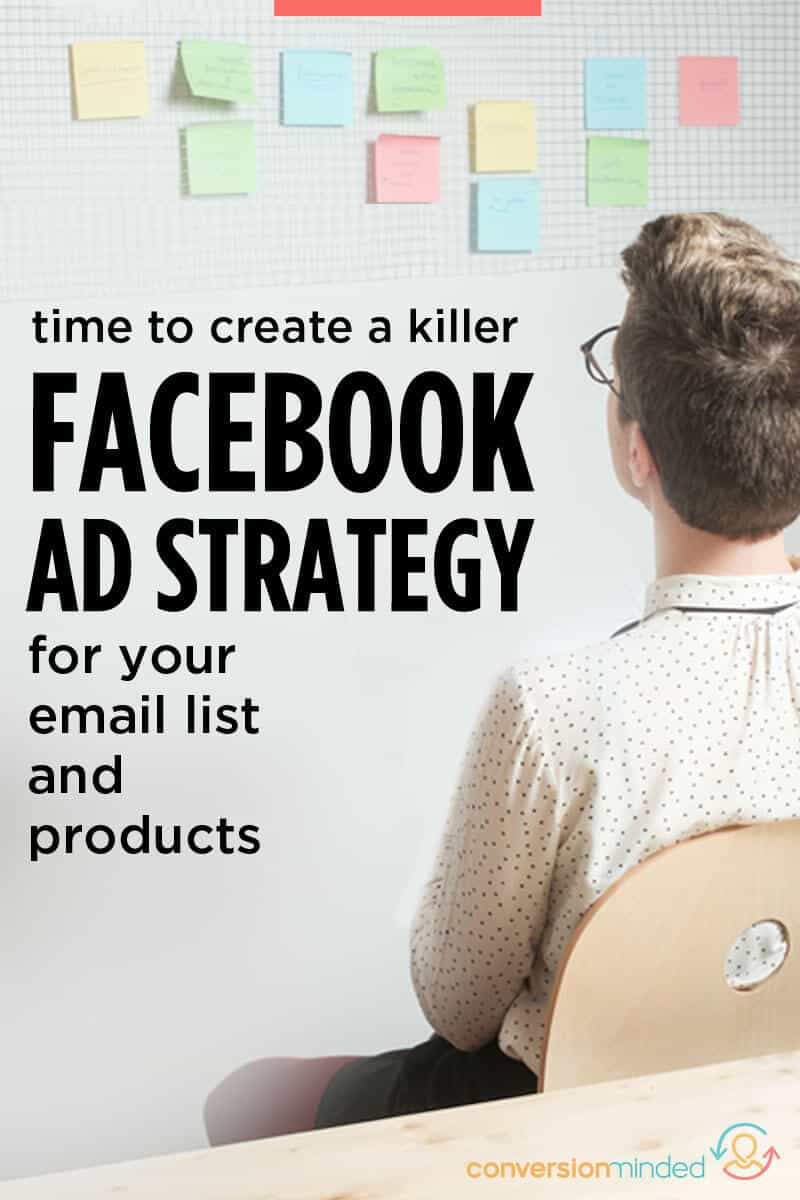Create a Killer Facebook Ad Strategy For Your Email List and Products
My first stab at Facebook ads was a simple Page Like campaign. I remember feeling nervous and scared about it, and maybe a little dewy-eyed at the same time.
I had no idea what I was doing, what type of ad I should run or why I was even running an ad in the first place. My Facebook ad strategy left a lot to be desired.
It all started with my clients throwing me curveball questions like What type of ad should I run? Where should we direct people? How do we track the ads? How do I get people back to my website?
Uh…no idea.
I finally broke down and asked my business coach for help. Together, we created my very first campaign. All the while, I wondered why we were spending so much effort, time, and money on Likes (like…what’s that about?).
Vanity, I guess. Wanting to impress my clients. Or, maybe fear that if my page had fewer than 1,000 fans, I wouldn’t be one of the cool girls.
Fast forward a few months later and my Facebook ad campaign strategy turned out to be a success, in more ways than one.
First off, my page got over 1,000 likes. Woo! More importantly, I learned a valuable lesson:
You need a Facebook ad strategy that’s bigger than Likes.
In this post, I’m sharing some hidden gems I’ve discovered since then that will help you use Facebook ads the right way – to build your list and get more sales.
Before we dig in, there are three main components to Facebook ads:
- Ad creative – your ad copy, image or video, and call to action
- Ad targeting and budget – how much you want to spend per day and who you want to reach based on interests and audiences
- Your landing/sales page – Where you direct people once they click your call to action
Much of what we’ll cover has less to do with the creative/techie side of things and more to do with sales funnels. I want to put #3 under a microscope and drill down on where to send people once they click on your ad.
Specifically, should you send them…
- To a sales page where you ask them to purchase right away?
- To a separate landing page with a free offer?
- To no page at all (gasp)?
To help answer these questions, let’s look at two common mistakes people make with Facebook ads:
Mistake #1: Asking for a sale right away
Driving people directly to a sales page and expecting them to dish out on a first date is tricky business.
Let’s use Harry as an example (Harry is a fictitious name based on a real person). Harry has a nutrition program to offer and is eager to bring it to market. He’s been working on it for months and thinks Once this product is finished, I’m set. This is so great, everyone’s going to want it! All I need to do is run an ad, send people to my sales page and then sit back and watch the money roll in. (not)
HOLD UP. Can this strategy actually work?
Sure it can. IF Harry has seed funding and a fat checkbook.
He’ll have to run his ads long enough to figure out: 1) who his target audience really is, and 2) if they love his product as much as he thinks they will. Plus, he’ll have a high customer acquisition cost (aka: huge ad spend) because he’s going directly for the sale.
Doesn’t matter where he runs the ad either. Harry can use Facebook, Google, Pinterest, Instagram, or Twitter for his ads and get similar results. His cost of acquiring customers will most likely be higher than he anticipated and higher than his budget. In my opinion, this is not the best Facebook advertising strategy.
#TAKEAWAY: Don’t send people directly to a sales page.
Mistake #2: Asking for nothing
This is the mistake that I made. Page Like and Brand Awareness ads keep people within the Facebook platform rather than driving them to a page on your website. Basically, asking for nada.
Sound familiar?
Based on my experience, what’s typically at fault is a lack of clarity around what you’re trying to achieve with your Facebook ad strategy.
Here’s where we can learn from Harry. Even though he’s misguided with his approach, he is crystal clear about his end goal: to sell a product. He simply needs to incorporate a sales funnel (more on that later) that will “pull people into a sale” rather than “push a sale on people”. Make sense?
Now, you’re probably thinking Okay then, where SHOULD I take people who click on my ad? And what should I ask them to do?
These are both great questions! The best ad strategies are ones that direct people to a landing page. First, I want to help you get crystal clear on what you want to achieve with Facebook ads.
Be very clear about what you want to achieve with Facebook ads before spending a dime.Click To Tweet#TAKEAWAY: Be very clear about what you want to achieve and make sure you send people somewhere.
Facebook ad goals and objectives
You probably have many things you want to achieve in your business, such as:
- I want more coaching clients
- I want more consulting clients
- I want to sell a digital product
- I want to grow my email list
- I want more sales on all my courses
- I want more sales on my new products
- I want to grow my Facebook engagement
- I want to grow my Facebook group
- I want more followers
- I want more traffic to my site
- I want to be known online
Whew! It’s a big list. To make it even more confusing, there are as many Facebook advertising options (or objectives) to choose from:
- Boost post – promote your blog post to increase reach
- Brand awareness – increase visibility of your brand and name
- Reach – get your ad seen by as many people as possible
- Traffic – drive people to a blog post of podcast
- Engagement – engagement on your ad (like, comment, share, reactions)
- App installs – get people to download your app
- Video views – get people to see videos you uploaded
- Lead gen – get people to sign up for your opt-in right on Facebook
- Conversions – drive people to a page where they take a specific action (sign up, download, buy a product)
- Product catalog sales – for e-commerce stores to promote their products
- Store visits – for local brick-and-mortar businesses to reach people nearby
The trick is to choose the right goals from the first list and the right objectives from the second list. We only want goals and objectives that will help us increase sales.
If you’re confused by all this, I’m going to clear it up for you real quick…
First of all, forget about every ad objective except Conversions. Bump.
Now, from our goals list, let’s call the top six (in bold) our Power Goals. These are the ones that will directly impact sales and business growth.
The bottom ones…those leading to more followers, traffic, brand awareness, and visibility…are lacking muscle, meaning that they won’t have a great impact on your bottom line. Since these Wimpy Goals will likely happen as a result of your Power Goals anyway, there’s no need to chase them down with Facebook ads.
I’ll go so far as to say that Wimpy Goals will leave you thinking that Facebook ads don’t work. After my first Facebook campaign, I steered clear of Facebook ads for a looong time. They’re a total waste of money I thought. Which, of course, they were because I’d set out with a wimpy Page Like goal.
Don’t do what I did!
Next up, remember those sales funnels I mentioned? Time for a funnels throwdown, yo.
Aim for a primary goal with Facebook ads – your secondary goal will likely happen as a result.Click To Tweet#TAKEAWAY: Always aim for a Power Goal with Facebook ads.
What is a sales funnel, anyway?
A funnel is simply a sequence of events you set up, where your target audience is first pulled into your content via a free training or awesome resource you offer, and then “gifted” additional content pieces that serve two primary purposes:
- To educate them about said topic
- To help them take actionable steps toward achieving something
- To lead people to a purchase
Essentially, funnels take people on a scenic route to their destination, which is your solution for them.
Even though your funnel has one business goal, the most heart-felt funnels will provide amazing value that potential customers would gladly pay for…only they don’t have to because you gift it to them. This means that if at any point they drop off without purchasing, they will be taking with them actionable steps to help them achieve a mission-critical goal.
Here’s what a basic funnel looks like:
 If funnels sound open-ended, as if you’ll be giving away the farm, I get it. Creating content takes a lot of time and effort. I’m five hours into writing this post and not one word has come easy, friend. 🙂
If funnels sound open-ended, as if you’ll be giving away the farm, I get it. Creating content takes a lot of time and effort. I’m five hours into writing this post and not one word has come easy, friend. 🙂
Still, I’m happy to do it! You know why? Because I get this little factoid:
People need a deeper relationship in order to buy from us.
Today, face-to-face networking is a ghost in our past, which means that the subtle innuendos and gestures we pick up on in person are missing. We have to rely on our content to fill in that gap and communicate who we are and where our expertise lies. Bottom line, gotta keep showing up, creating, and publishing.
Sales funnels should include free content that helps people achieve something and leads them to a purchase.Click To Tweet#TAKEAWAY: Free content pieces should provide extreme value and lead to your end goal.
Side note: What should Harry do?
Harry should shift his strategy from pushing a sale to pulling people into his content. Focus on building relationships with people first. THEN, after he’s provided value and earned the trust of his audience, he can gently introduce his product.
Here’s what Harry’s funnel might look like:
Now, let’s put funnels to work for your ad campaign…
How to create your own sales funnel
First, work backward from your end goal. Think about what it would take for you to reach that goal.
Step back. Even further. Step waaay back from your product. Imagine that you’re no longer the creator. You’re no longer YOU. You’re a complete stranger who will be discovering said product for the first time.
Now, ask yourself What would it take to get me excited about this? What would be most helpful to me at this point in my journey?
Next, put on your inventor hat again. What content pieces can you create that would be most relevant to your product? What would organically lead people to a purchase?
By looking at your product from both angles like this, you can bridge your free content pieces to your business goal. Don’t limit your content to blogging and Ebooks here. Mix it up with videos and/or podcasts to give your people a sense of a one-to-one interaction with you.
For example, let’s look at what it would take if your Power Goals are to:
- Build your email list
- Sell an introductory product
A SUPER SIMPLE LIST-BUILDING FUNNEL EXAMPLE
You’d start with a funnel that includes these pieces:
- A product – it can be a low-cost Ebook or workshop or a higher-priced course
- A free course or resource – relevant to both your audience and product
- A Facebook ad – with a conversion objective
- A landing page – where people can sign up for your free resource (use LeadPages)
- A thank you page – with an option to purchase the paid product
- An email provider – ConvertKit is my new fav (read this post for how to set it up)
Can you see how this type of funnel would put rocket fuel on your list AND increase sales at the same time?
Let’s do some math. Say you spend $100 to test your Facebook ad. The ad gives you 20 new email subscribers, three of whom buy your ebook for $40. You make $120 in revenue and $20 in profit.
If we play this out for a minute, here’s what would happen if you ramp up your Facebook ad strategy and spend $100 a day:
- 20 new subscribers a day
- 3 new customers a day
- $120 in revenue a day ($20 profit)
In one month, you’d have 600 new subscribers, 90 customers, $3,600 in revenue and $600 in profit. Bigger budget = more subscribers = more revenue.
So, how do you make this work?
The formula above uses a 20% conversion rate on ads and a 15% conversion rate on new-subscribers-to-customers.
I’m not going to lie. Hitting those numbers will take some work! First of all, you will need to create the content pieces. Then, you’ll need a winning combination of ad + landing page + free offer + paid product.
On the art side of the equation, you’ll need to have a deep understanding of what your audience most wants or needs. This is a biggie. If you jump into a full-blown ad campaign without solving a specific problem for people, it’s going to be hard to get results.
This is why starting with a small budget is so crucial. What you’re aiming for is to test your ads until one outperforms the others and yields a 20% conversion rate.
Don’t stop there…test your product, free gift, and landing page too.
I know you’re probably thinking This sounds like a ton of work!
I hear you. If you hang in there and stick with it, your investment will pay off as you get more subscribers and customers and see higher profit margins on your ads.
#TAKEAWAY: Use this funnel to supercharge your list and sell your products without spending money on ads.
What if you don’t have a product yet?
That’s perfectly okay. You can still dabble in FB advertising. You’ll be looking at a longer-term play and a different Power Goal, which is to fill your list with people who may be interested in a future product. (Psst…want to know my top 4 list-building strategies? Check out this post.)
In this case, I recommend driving traffic to:
- A standout blog post with a free offer
- A landing page with a free offer
Since your ad revenue here will be future-based, stay with the small budget and plan on gradually building your list until you’re closer to launch. By then you should know which ads are working and where to invest your dollars.
Include content pieces in your funnel that prime people for your product AND offer amazing education and value. Remember, we’re killin’ two birds with our funnels.
If you’ve been following our Blog Profit Plan series, you’re already blogging around content themes and it will be easy to gather valuable pieces. Then, all you have to do is to gift these resources to your audience in a natural, organic, and sensitive way. Easy peasy.
#TAKEAWAY: Use a small daily budget if your Power Goal is to build your email list and you have yet to create a product.







This was fantastic. Content outlined perfectly – like the little touches such as “click to tweet.” I got a lot out of this! Thanks!
I’m so glad it was helpful, Stacy!
Hi there. I enjoyed reading this but I still find it hard to think how it would fit with my business which is handmade jewelry. Could you point me in the right direction? What could my funnel be?? 😉
Hi Liat, I used to make temporary tattoos and clothing so I totally get that accessories can be tricky, but there’s a way to make it work. Don’t worry! You just have to find creative ways to bridge the gap between your jewelry and the challenges your audience may be having around maintaining jewelry, accessorizing, choosing the right jewelry, etc. Some things that come to mind for a possible Ebook to kick off your funnel: How to Clean Jewelry, Horoscope Stones or Rings, 5 Ways to Mix and Match Necklaces. With this last one, you can even incorporate your own jewelry. I wish you the best of success with it!